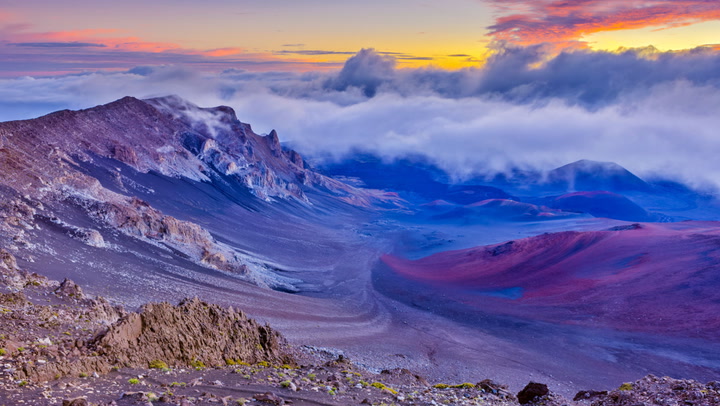Arguably one of the most far-flung national parks, Haleakalā National Park on Maui is a special place that leaves many with a deeper respect for Hawaii and its lands. Haleakalā soars above the sea, with a 10,000-foot summit at the rim of one of the world’s largest volcanic craters. It is also home to endangered species, some of which are found nowhere else in the world, and a variety of natural ecosystems, including rain forests and subalpine shrublands. With a profound history, precious wildlife, incredible scenery, and memorable activities, Haleakalā National Park deserves a spot on your travel itinerary. Here’s how to plan a remarkable trip.
Watch the Sunrise from the Highest Point in Maui
Haleakalā, meaning “House of the Sun,” is a fitting name for the park as over half a million people each year visit solely to witness the magnificent sunrise and sunset over the volcanic crater, the highest point on the island. According to legend, demigod Maui lassoed the sun to slow its rapid journey through the sky, allowing his mother, Hina, to dry her kapa (native bark cloth) during the day. Watching the sun rise above the 10,000-foot dormant volcano is a magical experience where the sky transforms from twilight to crimson to burnt orange. As the sun ascends above the ocean, Hawaiians sing a traditional song to welcome the sun. Reservations are necessary for sunrise viewing, but not for sunset.

Stargaze Like Never Before
If you prefer not to leave your bed around 3 a.m. for sunrise at Haleakalā, rest assured that sunset is equally stunning. Moreover, you can transition right into stargazing, which offers a breathtaking display of cosmic beauty. The open spaces and isolation of Haleakalā provide world-class night sky conditions. Visitors can revel in rare moonbows produced by moonlight, glimpse planets, and even see the Milky Way. Star maps are available at the visitor center for your exploration. For those seeking an active adventure while enjoying the crater views, daytime hiking trails are also available.

Zip Line for a Bird’s-Eye View
If you’re eager to see the Haleakalā area’s rich ecosystem from above, zip lining is an exhilarating way to explore as you soar above the treetops of upcountry Maui. Skyline offers zip-line tours that emphasize sustainability. While whizzing through the air on zip lines, crossing canyons, navigating over 90-foot drops, and traversing through eucalyptus trees, you can learn about the native flora and fauna of the region. Since 2002, the company has planted over 8,000 native trees as part of their conservation efforts.

Look for Wildlife
Covering over 30,000 acres, Haleakalā National Park is teeming with diverse plant and animal life, boasting more endangered species than any other site in the National Park System. The park hosts over 850 species of plants, including Haleakalā silverswords, which live for 90 years or more, bloom once, and then die. The nēnē (Hawaiian state bird) resides here, along with the Hawaiian petrel and six native Hawaiian forest birds. Additionally, the park includes frogs, fish, deer, axis deer, Hawaiian monk seals, bats, and a variety of other wildlife.





